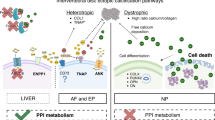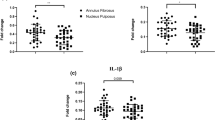Abstract
Purpose
Modic changes (MC) are associated with low back pain (LBP). Inflammation is considered as a key factor that triggers symptoms in especially type I MC, but so far of the potential inflammatory candidates only TNFα has been linked to MC. The objective of the study was to analyze a set of inflammatory mediators in human surgical disk samples and quantify their association with MC in the adjacent vertebral bodies.
Methods
The study sample consisted of 51 intervertebral disk tissue specimens; 20 ‘No MC’ disks, 19 ‘Type I MC’ disks, and 12 ‘Type II MC’ disks. mRNA expression of 46 cytokines was quantified from isolated RNA. Tissue samples were stained using hematoxylin and eosin, toluidine blue, Herovici, CD68 and CD163.
Results
No significant differences were found in the amount of macrophages or presence of chondrocyte conglomerates between the MC groups. Of the multiple genes tested, statistically significant associations were observed for M-CSF1 (p = 0.028), RANKL (p = 0.035), RUNX1 (p = 0.032), and RUNX2 (p = 0.047) that were increased in ‘Type II MC,’ while OSCAR (p = 0.042) was increased in ‘Type I MC’ group compared to ‘No MC.’
Conclusions
Since these cytokines are related to differentiation and proliferation of osteoclasts, our data suggest that the stimulation of vertebral osteoclasts by factors secreted by disk tissue is involved in the pathophysiology of MC.

Similar content being viewed by others
References
Modic MT, Steinberg PM, Ross JS, Masaryk TJ, Carter JR (1988) Degenerative disk disease: assessment of changes in vertebral body marrow with MR imaging. Radiology 166:193–199
Kjaer P, Leboeuf-Yde C, Korsholm L, Sorensen JS, Bendix T (2005) Magnetic resonance imaging and low back pain in adults: a diagnostic imaging study of 40-year-old men and women. Spine (Phila Pa 1976) 30:1173–1180
Kjaer P, Korsholm L, Bendix T, Sorensen JS, Leboeuf-Yde C (2006) Modic changes and their associations with clinical findings. Eur Spine J 15:1312–1319
Kuisma M, Karppinen J, Niinimäki J, Ojala R, Haapea M, Heliövaara M et al (2007) Modic changes in endplates of lumbar vertebral bodies: prevalence and association with low back and sciatic pain among middle-aged male workers. Spine (Phila Pa 1976) 32:1116–1122
Kerttula L, Luoma K, Vehmas T, Grönblad M, Kääpä E (2012) Modic type I change may predict rapid progressive, deforming disc degeneration: a prospective 1-year follow-up study. Eur Spine J 21:1135–1142
Jensen T, Karppinen J, Sorensen J, Niinimäki J, Leboeuf-Yde C (2008) Vertebral endplate signal changes (Modic change): a systematic literature review of prevalence and association with non-specific low back pain. Eur Spine J17:1407–1422
Ulrich J, Liebenberg E, Thuillier D, Lotz J (2007) ISSLS prize winner: repeated disc injury causes persistent inflammation. Spine (Phila Pa 1976) 32:2812–2819
Ohtori S, Inoue G, Ito T, Koshi T, Ozawa T, Doya H et al (2006) Tumor necrosis factor-immunoreactive cells and PGP 9.5-immunoreactive nerve fibers in vertebral endplates of patients with discogenic low back Pain and Modic Type 1 or Type 2 changes on MRI. Spine (Phila Pa 1976) 31:1026–1031
Karppinen J, Daavittila I, Solovieva S, Kuisma M, Taimela S, Natri A et al (2008) Genetic factors are associated with modic changes in endplates of lumbar vertebral bodies. Spine (Phila Pa 1976) 33:1236–1241
Karppinen J, Solovieva S, Luoma K, Raininko R, Leino-Arjas P, Riihimäki H (2009) Modic changes and interleukin 1 gene locus polymorphisms in occupational cohort of middle-aged men. Eur Spine J 18:1963–1970
Kazakia GJ, Kuo D, Schooler J, Siddiqui S, Shanbhag S, Bernstein G et al (2013) Bone and cartilage demonstrate changes localized to bone marrow edema-like lesions within osteoarthritic knees. Osteoarthritis Cartilage 21:94–101
Pfirrmann CW, Metzdorf A, Zanetti M, Hodler J, Boos N (2001) Magnetic resonance classification of lumbar intervertebral disc degeneration. Spine (Phila Pa 1976) 26:1873–1878
Määttä J, Kautiainen H, Leinonen V, Niinimäki J, Järvenpää S, Koskelainen T et al (2014) Association of Modic changes with health-related quality of life among patients referred to spine surgery. Scand J Pain 5:36–40
Braithwaite I, White J, Saifuddin A, Renton P, Taylor BA (1998) Vertebral end-plate (Modic) changes on lumbar spine MRI: correlation with pain reproduction at lumbar discography. Eur Spine J 7:363–368
Weishaupt D, Zanetti M, Hodler J, Min K, Fuchs B, Pfirrmann CW et al (2001) Painful lumbar disk derangement: relevance of endplate abnormalities at MR imaging. Radiology 218:420–427
Thompson KJ, Dagher AP, Eckel TS, Clark M, Reinig JW (2009) Modic changes on MR images as studied with provocative diskography: clinical relevance—a retrospective study of 2457 disks. Radiology 250:849–855
Kokkonen SM, Kurunlahti M, Tervonen O, Ilkko E, Vanharanta H (2002) Endplate degeneration observed on magnetic resonance imaging of the lumbar spine: correlation with pain provocation and disc changes observed on computed tomography diskography. Spine (Phila Pa 1976) 27:2274–2278
Lacey DL, Timms E, Tan HL, Kelley MJ, Dunstan CR, Burgess T et al (1998) Osteoprotegerin ligand is a cytokine that regulates osteoclast differentiation and activation. Cell 93:165–176
Quinn JM, Gillespie MT (2005) Modulation of osteoclast formation. Biochem Biophys Res Commun 328:739–745
Koga T, Inui M, Inoue K, Kim S, Suematsu A, Kobayashi E et al (2004) Costimulatory signals mediated by the ITAM motif cooperate with RANKL for bone homeostasis. Nature 428:758–763
Hofbauer LC, Schoppet M (2004) Clinical implications of the osteoprotegerin/RANKL/RANK system for bone and vascular diseases. JAMA 28(292):490–495
Nakamura I, Takahashi N, Jimi E, Udagawa N, Suda T (2012) Regulation of osteoclast function. Mod Rheumatol 22:167–177
Kim JH, Kim K, Youn BU, Jin HM, Kim JY, Moon JB et al (2011) RANKL induces NFATc1 acetylation and stability via histone acetyltransferases during osteoclast differentiation. Biochem J 436:253–262
Gruber H, Ingram J, Hoelscher G, Zinchenko N, Norton HJ, Hanley E (2009) Matrix metalloproteinase 28, a novel matrix metalloproteinase, is constitutively expressed in human intervertebral disc tissue and is present in matrix of more degenerated discs. Arthritis Res Ther 11:R184
Suda T, Takahashi N, Udagawa N, Jimi E, Gillespie MT, Martin TJ (1999) Modulation of osteoclast differentiation and function by the new members of the tumor necrosis factor receptor and ligand families. Endocr Rev 20:345–357
Choo MK, Yeo H, Zayzafoon M (2009) NFATc1 mediates HDAC-dependent transcriptional repression of osteocalcin expression during osteoblast differentiation. Bone 45:579–589
Chen C, Cui L, Shang X, Zeng X (2010) NFAT regulates CSF-1 gene transcription triggered by L-selectin crosslinking. Biocell 34:57–63
Kim N, Takami M, Rho J, Josien R, Choi Y (2002) A novel member of the leukocyte receptor complex regulates osteoclast differentiation. J Exp Med 195:201–209
Nemeth K, Schoppet M, Al-Fakhri N, Helas S, Jessberger R, Hofbauer LC et al (2011) The role of osteoclast-associated receptor in osteoimmunology. J Immunol 186:13–18
Herman S, Muller RB, Kronke G, Zwerina J, Redlich K, Hueber AJ et al (2008) Induction of osteoclast-associated receptor, a key osteoclast costimulation molecule, in rheumatoid arthritis. Arthritis Rheum 58:3041–3050
Yamagata T, Maki K, Mitani K (2005) Runx1/AML1 in normal and abnormal hematopoiesis. Int J Hematol 82:1–8
Tokuhiro S, Yamada R, Chang X, Suzuki A, Kochi Y, Sawada T et al (2003) An intronic SNP in a RUNX1 binding site of SLC22A4, encoding an organic cation transporter, is associated with rheumatoid arthritis. Nat Genet 35:341–348
Ducy P, Zhang R, Geoffroy V, Ridall AL, Karsenty G (1997) Osf2/Cbfa1: a transcriptional activator of osteoblast differentiation. Cell 89:747–754
Zanatta M, Valenti MT, Donatelli L, Zucal C, Dalle Carbonare L (2012) Runx-2 gene expression is associated with age-related changes of bone mineral density in the healthy young-adult population. J Bone Miner Metab 30:706–714
Maruyama Z, Yoshida CA, Furuichi T, Amizuka N, Ito M, Fukuyama R et al (2007) Runx2 determines bone maturity and turnover rate in postnatal bone development and is involved in bone loss in estrogen deficiency. Dev Dyn 236:1876–1890
Otto F, Thornell AP, Crompton T, Denzel A, Gilmour KC, Rosewell IR et al (1997) Cbfa1, a candidate gene for cleidocranial dysplasia syndrome, is essential for osteoblast differentiation and bone development. Cell 89:765–771
Martinez-Calatrava MJ, Prieto-Potin I, Roman-Blas JA, Tardio L, Largo R, Herrero-Beaumont G (2012) RANKL synthesized by articular chondrocytes contributes to juxta-articular bone loss in chronic arthritis. Arthritis Res Ther 14:R149
Lotz J, Fields A, Liebenberg E (2013) The role of the vertebral end plate in low back pain. Global Spine J 3:153–164
Wang F, Jiang JM, Deng CH, Wang FL, Fu ZZ, Zhang ZF (2011) Expression of Fas receptor and apoptosis in vertebral endplates with degenerative disc diseases categorized as Modic type I or II. Injury 42:790–795
Zanetti M, Bruder E, Romero J, Hodler J (2000) Bone marrow edema pattern in osteoarthritic knees: correlation between MR imaging and histologic findings. Radiology 215:835–840
Appel H, Loddenkemper C, Grozdanovic Z, Ebhardt H, Dreimann M, Hempfing A et al (2006) Correlation of histopathological findings and magnetic resonance imaging in the spine of patients with ankylosing spondylitis. Arthritis Res Ther 8:R143
van Duivenvoorde LM, Dorris ML, Satumtira N, van Tok MN, Redlich K, Tak PP et al (2012) Relationship between inflammation, bone destruction, and osteoproliferation in the HLA-B27/human beta2 -microglobulin-transgenic rat model of spondylarthritis. Arthritis Rheum 64:3210–3219
Wu HL, Ding WY, Shen Y, Zhang YZ, Guo JK, Sun YP et al (2012) Prevalence of vertebral endplate modic changes in degenerative lumbar scoliosis and its associated factors analysis. Spine (Phila Pa 1976) 37:1958–1964
Miyagi M, Ishikawa T, Kamoda H, Suzuki M, Murakami K, Shibayama M et al (2012) ISSLS prize winner: disc dynamic compression in rats produces long-lasting increases in inflammatory mediators in discs and induces long-lasting nerve injury and regeneration of the afferent fibers innervating discs: a pathomechanism for chronic discogenic low back pain. Spine (Phila Pa 1976) 37:1810–1818
Lee S, Moon CS, Sul D, Lee J, Bae M, Hong Y et al (2009) Comparison of growth factor and cytokine expression in patients with degenerated disc disease and herniated nucleus pulposus. Clin Biochem 42:1504–1511
Richardson SM, Doyle P, Minogue BM, Gnanalingham K, Hoyland JA (2009) Increased expression of matrix metalloproteinase-10, nerve growth factor and substance P in the painful degenerate intervertebral disc. Arthritis Res Ther 11:R126
Acknowledgments
We received funding from the AO Spine (Hansjörg Wyss Reward for Dr. Karppinen).
Conflict of interest
None.
Author information
Authors and Affiliations
Corresponding author
Rights and permissions
About this article
Cite this article
Torkki, M., Majuri, ML., Wolff, H. et al. Osteoclast activators are elevated in intervertebral disks with Modic changes among patients operated for herniated nucleus pulposus. Eur Spine J 25, 207–216 (2016). https://doi.org/10.1007/s00586-015-3897-y
Received:
Revised:
Accepted:
Published:
Issue Date:
DOI: https://doi.org/10.1007/s00586-015-3897-y




